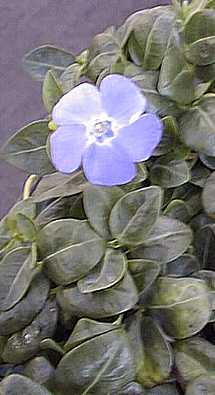Sunset®: 5-24, 28-31
AHS: 9-1
USDA: 8-10
Frost Tolerance: Hardy to 10°F (-12°C)
Sun Exposure: Light shade to shade
Origin: Southern Europe
Growth Habits: Evergreen trailing perennial to 10 inches tall (22.5 cm), can become invasive
Flowers: Blue flowers
Watering Needs: Fairly drought resistant, fast grower with regular water
Propagation: grows roots whenever a stem touches the ground
Propagation: Cutting
- by softwood secondary cuttings. Use intermittent mist. Root in 2-4 weeks. Cuttings may be collected at any time..
Vinca minor L., common periwinkle, is a perennial evergreen ground cover that is winter hardy. It is closely related to the big leaf periwinkle (V. major L.), except in size and hardiness. Common periwinkle seldom exceeds a height of 6 inches although runners may trail long distances on the ground. The runners root at the node under moist conditions. The thick glossy leaves form a good ground cover.
This plant may become weedy or invasive in some regions or habitats and may displace desirable vegetation if not properly managed.
The species name "minor" comes from the Latine for "smaller".
Blooming Habits:
Small blue flowers occur indeterminately from April to September. Blooms better with more sun.
(Source USDA/NRCS)
Culture:
Common periwinkle is adapted to mild climates. It usually requires part shade and ample moisture, but will tolerate full sun if it is adequately watered. It is more hardy than big leaf periwinkle. Moisture and exposure are often more restrictive than soil type on determining adaptation.
Common periwinkle is adapted to a wide range of soils. It is found on well drained to poorly drained soils that can be calcareous, alkaline to slightly acidic, and medium textured to fine textured. The plant should be used where there is adequate moisture.
Propagation:
Plants may be established from rooted cuttings produced in flats or from plant division. Plant on a spacing of 18 inches x 18 inches. Fertilizer should be applied for vigorous establishment. Mulch critical areas immediately after planting. Planting can be done any time of the year when moisture is adequate for establishment. This should ordinarily be planted on areas that can be sprinkled or otherwise irrigated or on sites where average annual precipitation is over 20 inches.
Common periwinkle can be affected by blight, canker, leaf spot, and root rot.
Desert-Tropicals is dedicated to provide gardening advice, gardening ideas, and information about flower of all kind for landscape and collections.We try to check carefully the identification of the plants on the illustrations as well as the other information from the page, but occasionally errors do occur. if you notice anything that needs to be changed please contact us.Thanks.
© 1998-2020 Philippe Faucon, All Rights Reserved.
